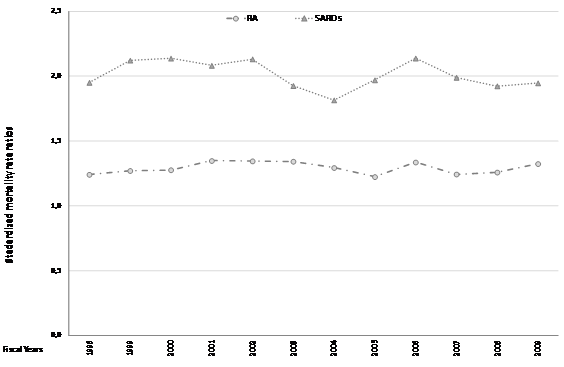Session Information
Session Type: Combined Abstract Sessions
Background/Purpose:
Health administrative data (HAD) are a potentially efficient to conduct population-based research and are increasingly used to develop chronic disease surveillance indicators. Examining trends in incidence and mortality over time can assist in monitoring disease burden and evaluating the effectiveness of treatment. The aim of this study was to explore time trends in incidence and mortality for rheumatoid arthritis (RA) and selected systemic autoimmune rheumatic diseases (SARD).
Methods:
Using case definitions for HAD available in Quebec, Canada, 2 population-based cohorts for RA and SARD (1996-2010) were defined. To identify incident cases, a «run-in» period of 5 years (1996-2000) was used to exclude prevalent cases. Age and sex-specific incidence rates were calculated using the number of incident cases as the numerator and the counts of population eligible for health insurance registry as the denominator. Age-standardized incidence rates (SIR) were calculated using the 2001 age-structure of the Quebec population. Health insurance registry file was also used to identify deaths among 2 cohorts and, for each year, mortality rates in each cohort were compared with mortality rates in the general population using standardized mortality rate ratios (SRR). Joinpoint and negative binomial regression analyses were used to test for linear change in incidence rates and SRR.
Results:
Prevalence of RA and SARD in 2009 were estimated at 1100.7 and 529.8 per 100,000 persons, respectively. For RA, 69.2% of cases were females, while for SARD, this percentage was 73.5%. The linear trends in SIR did not show significant change over the study period (RA p-value=0.3613, SARD p-value 0.0510) (Fig. 1 and 2). The mortality rate in RA and SARD patients was significantly higher than the expected rate in general population (2009: RA SRR=1.32, SARD SRR=1.95), and no significant improvement was observed (Fig. 3).
Conclusion:
No secular trends in SIR of RA and SARD were observed over time. The mortality was substantially higher in RA and SARD compared to general population, and remained so over the study period. This suggests further efforts are needed to optimize long-term outcomes in these diseases.
Disclosure:
S. Jean,
None;
P. Gamache,
None;
M. Hudson,
None;
L. Bessette,
None;
P. R. Fortin,
None;
G. Boire,
None;
S. Bernatsky,
None.
« Back to 2013 ACR/ARHP Annual Meeting
ACR Meeting Abstracts - https://acrabstracts.org/abstract/trends-in-incidence-and-mortality-in-rheumatoid-arthritis-and-systemic-autoimmune-rheumatic-diseases-in-quebec-canada-a-population-based-study/



